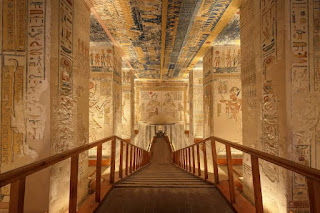Ancient Egypt is undoubtedly one of the most fascinating civilizations in history. From the pyramids to the pharaohs, the mythology to the art, there is something about this ancient culture that captures the imagination. For those who are interested in uncovering the history of Ancient Egypt, there are a number of must-see sites that offer a glimpse into this incredible civilization. In this blog post, we will explore some of these sites and what they have to offer.
1. The Pyramids of Giza
Perhaps the most iconic symbol of Ancient Egypt, the Pyramids of Giza are a must-see for anyone interested in this civilization. Located on the outskirts of Cairo, these pyramids were built as tombs for pharaohs during the Old Kingdom period. The largest and most famous of the pyramids is the Great Pyramid of Khufu, which stands at over 140 meters tall. Visitors can explore the inside of the pyramids, and learn about the engineering feats that made their construction possible.2. The Sphinx
Located near the Pyramids of Giza, the Sphinx is a mysterious and awe-inspiring site. This statue, which stands at over 20 meters tall, has the body of a lion and the head of a human. The purpose of the Sphinx is still debated by scholars, but it is believed to have been built during the reign of the pharaoh Khafre in the Old Kingdom period. Visitors can admire the Sphinx from all angles, and learn about the many theories surrounding its construction and meaning.3. The Valley of the Kings
Located on the west bank of the Nile near Luxor, the Valley of the Kings is a site of incredible archaeological significance. This valley was used as a burial site for pharaohs and their consorts during the New Kingdom period, and contains over 60 tombs. Visitors can explore the tombs and learn about the religious beliefs and burial practices of Ancient Egyptians.4. Karnak Temple Complex
Located in Luxor, the Karnak Temple Complex is one of the largest religious complexes in the world. This temple was dedicated to the god Amun, and was built over a period of 2,000 years. Visitors can explore the various temples, obelisks, and statues that make up the complex, and learn about the mythology and religious practices of Ancient Egyptians.5. Abu Simbel
Located in southern Egypt, Abu Simbel is a site of incredible beauty and historical significance. These temples were built by the pharaoh Ramses II during the New Kingdom period, and were designed to commemorate his victory at the Battle of Kadesh. The temples were relocated in the 1960s to avoid being flooded by the construction of the Aswan High Dam, and are now a UNESCO World Heritage Site. Visitors can marvel at the intricate carvings and architecture, and learn about the history and mythology of Ancient Egypt.6. Luxor Temple
Located in the heart of Luxor, the Luxor Temple is a site of great religious and historical significance. This temple was dedicated to the god Amun, and was built during the New Kingdom period. Visitors can explore the various temples, halls, and courtyards that make up the complex, and learn about the religious practices and beliefs of Ancient Egyptians.In conclusion, uncovering the history of Ancient Egypt is a fascinating journey that can take you from the pyramids to the temples, from the pharaohs to the mythology. The sites listed above offer a glimpse into this incredible civilization, and are a must-see for anyone interested in history, archaeology, or mythology. So if you are planning a trip to Egypt, be sure to add these sites to your itinerary and discover the wonders of Ancient Egypt for yourself.
Tag : Ancient Egypt historical sites, Pyramids of Giza history, Luxor temple guide, Tutankhamun tomb discovery, Karnak temple facts, Ancient Egyptian civilization timeline, Abu Simbel temple significance






